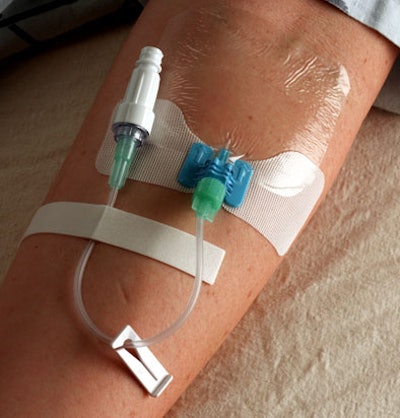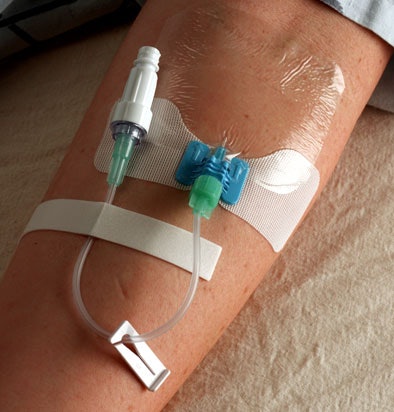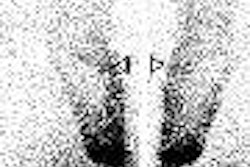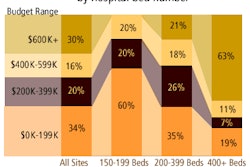
It's time to rethink the subject of catheter stabilization, including for peripherally inserted central catheter (PICC) lines. That's the message from new Standards of Practice issued this year by the Infusion Nurses Society (INS), the world's leading medical organization dedicated to infusion therapy. While these new national standards come from a nursing body, they are firmly evidence-based and thus of keen interest to the radiology community, especially with respect to PICC lines.
PICCs are customarily sutured or taped into place, with the more difficult placements often performed by an interventional radiologist. But INS concluded that there is no basis to recommend either tape or suture for stabilizing these catheters. The society based this conclusion on its careful examination of a rapidly accumulating body of scientific evidence about a better alternative.
The new Infusion Nursing Standards of Practice recommend one stabilization method above all others: customized, suture-free, and tape-free "manufactured catheter stabilization devices" (also known as securement devices). The standards do list three different securement methods: manufactured catheter stabilization devices, sterile tape, and surgical strips. But the new guidelines also declare: "Whenever feasible, using a manufactured catheter stabilization device is preferred."
The INS isn't the only authority to cite the advantages of using a device specially designed for holding PICCs and other catheters in place. Relying on studies published in the Journal of Vascular and Interventional Radiology (JVIR) and elsewhere, the Centers for Disease Control and Prevention (CDC) and the Occupational Safety & Health Administration (OSHA) have also taken note.
A large body of evidence has accumulated in the past few years to establish the superiority of catheter stabilization devices. A typical customized catheter securement/stabilization device consists of (1) a skin-safe, alcohol-soluble adhesive system that fixes an anchor pad to the patient's skin, and (2) a retention mechanism for connecting the catheter or tubing to the anchor pad, which severely restricts catheter motion.
Particularly notable in the new standards is the elimination of suture as an acceptable method. That's largely because suture securement has been implicated as a cause of catheter-related bloodstream infections (CRBSIs), which are potentially fatal. As many as 250,000 patients in the U.S. suffer these infections each year, with an attributed mortality rate as high as 52,500 patients annually.
Study published in JVIR
One key study for radiology applications, cited in the new INS Standards, appeared in JVIR, authored by Dr. Alvin Yamamoto and Dr. Gregory Schears (JVIR, January 2002, Vol. 13:1, pp. 77-81). They reported on a prospective, randomized study at the Hospital of the University of Pennsylvania in Philadelphia, in which 85 patients who needed PICCs had their catheters secured with suture. Another cohort of 85 similar patients had their catheters secured with a customized PICC stabilization device.
The results showed the stabilization device secured catheters as well or better than suture, and was a much safer alternative for both patients and clinicians. The device resulted in a statistically significant reduction in PICC-related bloodstream infections, from 10 total infections with suture to only two with the study device. (The device also eliminated accidental needlestick injuries among clinicians placing the PICCs, while there was one needlestick injury in the suture group.)
 |
| A manufactured catheter securement device. |
These advantages may not be widely recognized in the radiology community, because radiologists don't often see cases of downstream infection subsequent to catheter insertion. But these infections related to suture are nonetheless well documented and dangerous.
What accounts for this dramatic and statistically significant reduction in CRBSIs with a customized securement device? In their discussion, the authors note that the pathogenesis of CRBSIs involves migration of skin flora through the percutaneous entry site. Suturing likely promotes bacteria colonization at the catheter access site, thus increasing the probability of bloodstream infection.
A sterile securement device, by comparison, does not disrupt the skin in the site area, and it appears to reduce the catheter "pistoning" in and out that is also associated with higher infection rates. It also facilitates easier cleaning of the site.
What about taping PICCs, an approach that is not recommended by INS but is nonetheless quite common? In another clinical study, Schears and colleagues compared a customized pediatric securement device to threaded tape. They concluded that the device provided a statistically significant reduction in unplanned removals, dislodgments, and migrations, among other advantages. This study also found a strong, though not statistically significant, trend toward reduction in CRBSIs with the manufactured catheter stabilization device.
An article in Clinical Infectious Diseases (May 15, 2002, Vol. 34:10, pp. 1362-1368) by leading infection control experts Dr. Christopher Crnich and Dr. Dennis Maki also highlighted the ability of a manufactured catheter stabilization device (StatLock, Venetec International, a division of C.R. Bard of Murray Hills, NJ) to dramatically reduce CRBSIs, compared to suture. The authors' meta-analysis of data on the device showed that it significantly dropped the bloodstream infection rate from 10% to less than 1%.
Crnich and Maki wrote in part: "The potential for this device to reduce infection may derive from the elimination of festering skin suture wounds that are contiguous to the newly inserted catheter and from minimization of the to-and-from pistoning of the catheter, which may promote invasion of the tract by cutaneous microorganisms through capillary action."
CDC and OSHA conclusions
Also part of the evidence base for the new INS standards are guidelines from the CDC for the prevention of IV-catheter-related infections. The latest CDC guidelines note that "sutureless securement devices can be advantageous over suture in preventing catheter-related BSIs."
As Yamamoto and Schears found in their JVIR study, suture needles can also cause needlestick injuries to clinical staff. Research shows that physicians suffer accidental needlesticks between 1.2% and 2% of the time when suturing central lines alone. Given that some 3 million central lines are placed each year, as many as 60,000 needlestick injuries may be occurring annually -- and needlessly -- from these placements. Recognizing this danger, OSHA guidelines state that securement devices "may decrease or eliminate the need for sutures and thus directly reduce needlesticks."
Dialysis catheters are often sutured, too. These catheters alone are associated with reported CRBSI rates of up to 54% and an attributable mortality rate of 30%.
As INS has recognized, a substantial body of research supports the need to change from the old, habit-based methods of using tape and suture to stabilize catheters, and to instead use a manufactured catheter stabilization device whenever feasible.
By Dr. Steve Bierman
AuntMinnie.com contributing writer
July 5, 2006
Dr. Steve Bierman is a former emergency room physician who is on the clinical faculty at University of California San Diego School of Medicine and serves as a consultant for Bard Medical.
Copyright © 2006 AuntMinnie.com



















